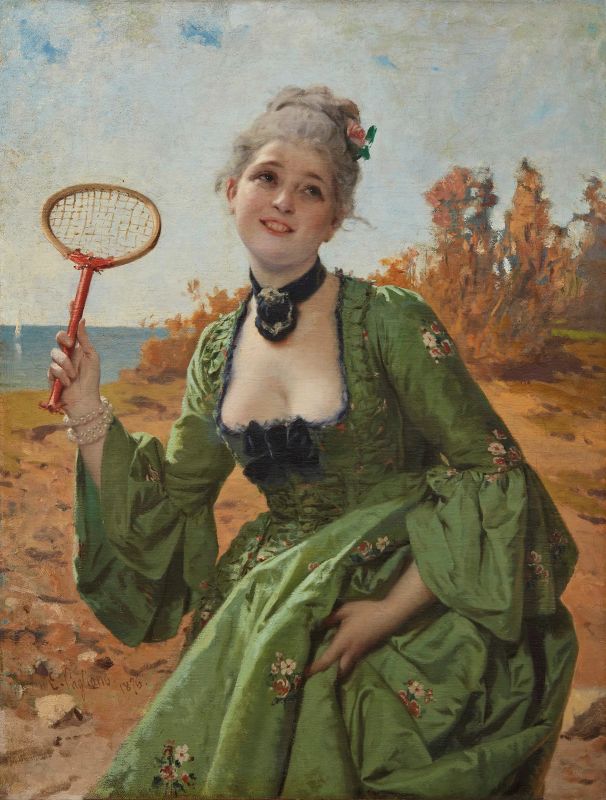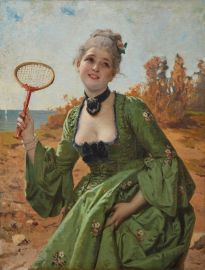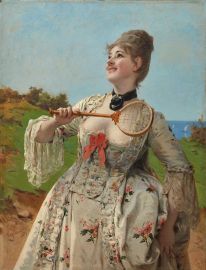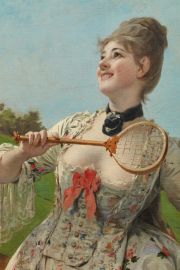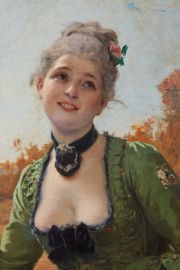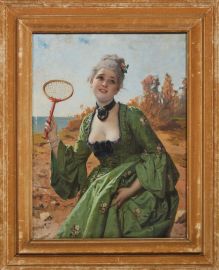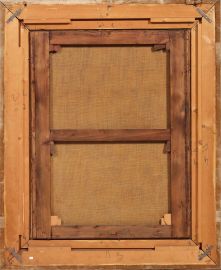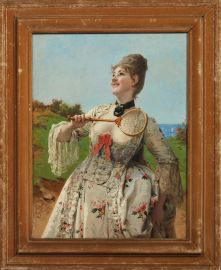Eleuterio Pagliano (Casale monferrato, 1826 - Milano, 1903)
Eleuterio Pagliano
Eleuterio Pagliano
(Casale Monferrato 1826 - Milano 1903)
THE BADMINTON PLAYERS
a pair of oil paintings on canvas, 106x81 cm
signed and dated "1876" lower left
(2)
An export licence is available for this lot
Provenance
Collezione Carraro Rizzoli, MilanoCollezione privata
The two paintings of equal dimensions we are presenting here, from the Carraro Rizzoli collection of Milan and now in another private collection, depict two coquettish young women posing with badminton racquets.
The two works were painted to hang side-by-side in such a manner as to simulate – both in composition and in gesture – an actual badminton match played outdoors, leaving the observer with the impression of being a real spectator at a real game between two (real) smiling young ladies. The charming evocation of the pastime orchestrated by Eleuterio Pagliano in these two lovely companion pieces proposes the minute descriptions, ‘at brush point’ as it were, generally associated with such costumed genre scenes. The rendering of the players’ 18th-century costume, their laces, rustling silks and velvet ribbons attest to Pagliani’s intention to exhibit his calligraphic virtuosity and his attention to every detail. The background landscape, the bushes, the sea and the sails on the horizon, painted with a less controlled brushstroke, call into play the naturalistic solutions with which the artist experimented en plein air in Griffa on Lago Maggiore.
The politely mischievous tone of the two costumed compositions speaks to a generous sensuality with the plunging necklines of the girls’ bodices which highlight their fresh, provocative beauty. Most surely, this joyous comeliness constituted one of the major attractions of this pair of canvases. To the point that the painter replicated them several times, introducing variants in response to the increasingly frequent requests for similar works by his well-to-do upper middle class clientele, both Italian and international. One example is a work entitled Giocando a cerchietti (Ring Toss), now in a private collection, which was documented in the past by Florentine art dealer Luigi Pisani. The two paintings presented at this sale fall neatly into the period which began in the early 1870s, in which Pagliani favoured a neo-eighteenth century style, as did two other eminent painters active in Milan at the same time: Gerolamo Induno and Mosè Bianchi. In that same period, Pagliano garnered considerable success with his 1875 painting L’estate di San Martino (Saint Martin’s Summer or Indian Summer), now at Milan’s Galleria d’Arte Moderna and with his La lezione di geografia (The Geography Lesson), painted in 1880 and held by Fondazione Cariplo, Milan.
BADMINTON
The game of badminton, a variant of earlier jeux de volant, has ancient roots and is considered the first modern racquet sport ever played. The earliest mentions of a similar game appear on Chinese vases dating to circa 500 BCE: depictions of young women playing with wooden racquets and a ball-like object to which a tuft of feathers is attached on one side. The name of that game (in which use of the feet was permitted) was ti jian zi and from China, it spread to Japan, Siam and India and eventually to the Sumerians and the Greeks. The oldest evidence of the arrival of the ‘birdie’ in modern Europe takes the form of English woodcut illustrations, dating to the 14th and 15th centuries, showing village dwellers using wooden paddles (battledores) to send a projectile (the shuttlecock) flying back and forth. By the late 16th century, the game had become a popular children’s pastime; painters and writers included it as a motif in their works, and even Shakespeare refers to tennis-like sports in several plays. During the French Revolution, it was in great vogue amongst broad swaths of the bourgeoisie and became a popular lawn game. There is evidence that the game was played at the major courts; by King Francis I of France, Queen Christina of Sweden, Frederick II of Prussia and even Catherine the Great of Russia. At these levels, the shuttlecock was placed in play by a servant; hence the term ‘to serve’ which later came into use in tennis as well. The transition toward the modern sport of badminton came in about 1860 in England and more precisely at the Duke of Beaufort’s Badminton House in Gloucestershire. Legend has it that several English officers, home on leave from Poona, India, suggested to the duke’s young daughters, who were playing battledore and shuttlecock in the great hall, to string a cord from wall to wall and to hit the birdie inside the half-court thus created but outside of their opponent’s reach to win a point.
A great number of works from past centuries, by artists from all over Europe, depict scenes of versions of the sport. One of the earliest is a miniature in a Book of Hours dated circa 1400 at the Bodleian Library in Oxford: it depicts two young women playing a version of the game, with wooden racquets and a feathered ball. A very similar scene appears in a watercolour by Dutch artist Adriaen van de Venne (1589-1662), but this time the players are two high-ranking ladies – evidence of how popular the game of battledore and shuttlecock had become at the courts. A series of etchings by French artist Nicolas Arnoult (ca. 1650 – ca. 1722) contains one work depicting the game – by that time quite fashionable – in which particular attention is paid to the clothing of the figures shown holding the racquets. That the sport was a worldwide phenomenon is shown by a woodcut, by Japanese artist Okumura Masanobu (ca. 1686 – 1764), of a courtesan dressed in an elegant kimono, caught at the moment she strikes the shuttlecock with her racquet.

